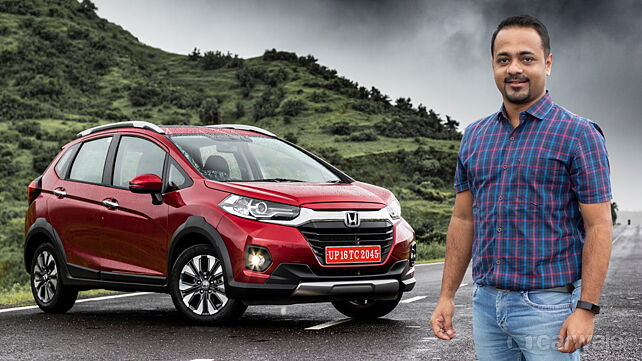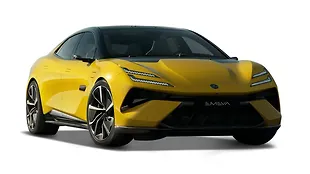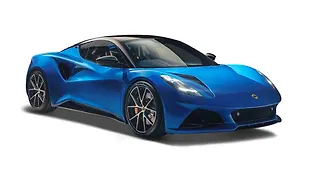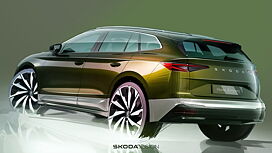What is it?
Why should I buy it?
Spacious interior, practicality, frugal diesel engine
Why should I avoid it?
Lacks road presence and some features

What is it?
This is the latest iteration of Honda's WR-V with BS6 updates and changes, both, on the inside and outside. The WR-V brand was introduced in India back in 2017. It was designed and developed to cater to the demands of Indian customers. And it's no secret that it's based on the Jazz hatchback. In fact, it was meant to better its proposition with a crossover styling. Does it continue to do that well? We find out.

The WR-V is still shorter than four metres in length so it avails all sub-four metre benefits in our country. Up front, the distinctive yet busy styling continues with a new grille with horizontal slats and a chrome insert. There are new LED projector headlamps, integrated DRLs and LED fog lamps as well. Its side profile remains unchanged and so does the rear, save for the new C-shaped LED tail lamps. The silver skid plates, black cladding, 16-inch alloys and higher ground clearance than the Jazz, help give it that beefed-up appeal.

How is it on the inside?

Now inside, you have this tilt and telescopic steering wheel and adjustments for these supportive seats that give you a good driving position. And a high seating allows a good view of the road ahead. The dash continues with the hard plastics and it still reminds you of the Jazz with its design and layout. It's well laid out though, with many cubby holes for storage and even the controls are easily within reach. Also, there's this 2.0 version of Honda's Digi-Pad with a 7.0-inch touchscreen infotainment system. It's compatible with Android Auto and Apple CarPlay, and gets many customisation options. This time around, it feels much better with good feedback and response times.

Given the tall and wide stance of the car, we know the interior is spacious and that you can clearly see in the second row. In fact, this is one of the most spacious ones out there even for three individuals like me. Still, we would have loved the rear seat if it provided more under-thigh support and had got adjustable headrests. Long journeys then would have been an even more pleasant affair. Then, the second-row occupants are also going to complain about no separate air-con vents, a centre arm-rest and a charging port. And if you are a previous-gen Jazz owner like me, there are things you will miss in this car. Especially the magic seats that added so much of versatility. This one here doesn't even get a 60:40 split. Otherwise, a 363litre boot is good enough to hold your weekend trip luggage.

Apart from these small features that are missing, it still continues to be packed with a lot of equipment in the top-end versions. Its USP continues to be this automatic AC with a touchscreen panel and a one-touch electric sunroof. People who are aware of the HDMI port in the earlier model, it's now replaced by an additional USB port given the need of users these days. Even on the safety front, it continues to get airbags for driver and the front passenger, ABS with EBD, a multi-view rear camera and rear parking sensors among others.

How does it drive?

The WR-V continues to get the 1.2-litre i-VTEC petrol and 1.5-litre i-DTEC diesel engine options that we have seen on the Honda Jazz. These are now BS6 compliant and the one here is a diesel unit. This diesel motor with its low-friction aluminium construction produces 98bhp and 200Nm of torque. It comes mated to a six-speed manual gearbox. Honda has improved the NVH levels, and with the AC and stereo on, the engine noise is almost muffled. That said, you can still hear the diesel clatter and it gets more prominent at higher revs. Good thing is that you never have to work the engine till its rev-limiter at 4,000rpm, as it has a good low and mid-range. There's so much of usable torque coming in linearly that you can drive it at 1,500rpm all day long. This tractable engine even responds well to throttle inputs and you'll hardly find yourself shifting gears too often.

And, do you know why this diesel is so popular? Because it has always been very fuel-efficient and this one now has a claimed fuel economy of 23.7km to a litre! As compared to its BS4 counterpart, this has actually dipped by around 1.7kmpl. But that again doesn't make it any less frugal. Thanks to the great drivability you will mostly be operating at lower rpms and saving fuel. Furthermore, the sixth gear acts as an overdrive on the highway improving fuel efficiency even more.

What you'll also appreciate is how easy and effortless the controls are. The clutch is surprisingly light for a diesel and the gearshifts though a little rubbery are still smooth. Whenever you steer the car, it responds well through a nicely weighted steering. Its compact footprint enables it to go around corners with poise as well. But there's some amount of body roll due to the soft suspension, which otherwise imparts it an impressive ride quality. Even if you miss a certain speed breaker or a pothole, it doesn't go crashing through it. It has a soft edge and isolates broken roads and rough patches well. This does mean you miss a relatively flat ride on the highway, but it strikes a good balance in between.

Should I buy one?

The WR-V looks quite different. It is stylish but still doesn't have that road presence that an SUV commands. That might be a concern for the ones expecting it. But, it still remains to be quite a good package. The ex-showroom pricing starts from Rs 8.50 lakh for the petrol SV variant and goes up to Rs 11 lakh for this top-spec VX diesel trim. That's pricey but customers in the past have accepted the premium they pay over the Jazz as Honda has already sold one lakh units of this model. The new one continues to be backed by a spacious interior, respectable quality and has all the traits of a practical family car. In fact, it enhances it with good ground clearance and ride quality for its positioning as a compact crossover.

Where does it fit in?
Most of the cross hatchbacks like the Hyundai i20 Active, Toyota Etios Cross, VW Cross Polo etc. have been discontinued in India. The WR-V is the only one that continues to be on sale and goes up against the Ford EcoSport, Hyundai Venue, Tata Nexon, Maruti Brezza and other compact crossovers/SUVs in the sub-four metre segment.

Pictures by Kapil Angane



































